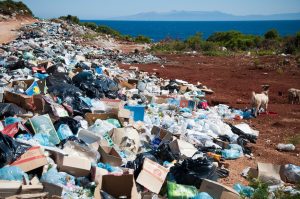[vc_row][vc_column][vc_column_text]
To Mountaineers: Stop Polluting, Switch to Hemp Bioplastic
When you hear “plastic pollution” what do you picture?
Beaches full of litter, oceans polluted to the brim, marine animals dying, the streets of India’s Tier-III cities, right?
Well, I recommend you add some icy mountain caps to that list. Because our plastic waste has reached the top of mountains. And it’s all thanks to mountain enthusiasts

Millions of kilograms of plastic are lost into the environment every year. Where does it all go?
Among other places, is a site very close to home…
The plastic trail to Mount Everest’s top
From the Mariana Trench (the deepest point on Earth) to the peak of Mount Everest (the highest point on Earth) plastic is everywhere. We have successfully polluted the entire planet with our litter.
Seems unreal? Don’t believe me?
Here are some hard facts, collected from newspapers and surveys, and attested by scientists, to back up my claims:
Scientists have discovered traces of plastic fibers in snow samples from Mount Everest. This snow was collected close to the peak, called the “balcony”.
Microplastics have also been found in 11 other locations on Everest, where snow samples were collected. The altitude was between 5,300-8,440 meters.
So far, the highest concentrations of microplastics have been detected around the base camp. This is where campers spend most of their time.
The most contaminated snow samples contained 119 particles per liter of water. The average was 30 microplastic particles per liter.
Scientists speculate the origin of these plastic fibers to be clothing, tents, and ropes used by mountaineers.
Even the remote areas of the Swiss Alps and French Pyrenees are prone to plastic waste. Reports indicate particles could have reached here through the wind currents.
According to a survey, the most common types of waste encountered at high altitudes by mountaineers are hard and soft plastics. This mainly includes plastic food packaging, first aid equipment, mountaineering equipment, plastic bottles, and plastic bags.
The same survey, conducted across 74 countries, revealed that the persuasive issue of plastic waste affects mountain regions across the globe. Two-thirds of mountaineers spot litter almost every time they visit a mountain. India is not an exception.
The consequence: Plastic usually contains toxic additives and carries harmful microbes. This injures wildlife that mistake it for food. Human beings also inhale plastic articles through the air and consume them via food and water. Not to mention, the scenic beauty of the impeccable, pristine mountainous regions, is completely ruined.
What is hemp plastic and how can it help?
Well, we cannot eliminate plastic with a snap of our fingers. What can we do?
We can solve the most notorious issue with plastic—its persistence to stick around. In other words, we can use plastic that disintegrates after disposal. The word you are looking for is “bioplastics”.

While bioplastics can be made with several organic components, I am an advocate of hemp. Hemp plastic is made of hemp cellulose. The hemp plant contains 65-70% cellulose, which is extracted and combined with other components to make hemp plastic. While most bioplastics are a cocktail of organic and synthetic fibers, some are 100% organic. These are usually made of plant cellulose, like starch waste from corn and potato. Hemp plastic is one such bioplastic.
Why am I so biased towards hemp plastic? Here are my reasons:
Biodegradability: Hemp is a 100% natural fiber. Hemp plastic degrades within 3-6 months of disposal. It can also be recycled indefinitely. It isn’t harmful to wildlife even if ingested, since hemp plastic is non-toxic.
Agricultural benefits: Hemp grows in 3-5 months, uses minimal amounts of water, thrives during all seasons of the year, gives a high yield, uses low amounts of energy, replenishes the soil with nutrients, and doesn’t require pesticides or herbicides. No other organic crop has this many benefits.
Durability: Due to the herculean strength of hemp fiber, the plastic produced from hemp is equally strong. It is 2.5 times stronger and 5 times stiffer than polypropylene. It is also lightweight due to the porous nature of hemp.
Heat resistance: Hemp plastic is known for its dimensional stability along with its thermal and UV resistant properties. Some special kinds of hemp plastic are even flame resistant.
Carbon negative: Hemp absorbs more carbon dioxide than it generates during its life cycle. It helps reduce the greenhouse effect as it doesn’t release any carbon dioxide as it decomposes.
Economical advantages: Since it is grown in the mountainous terrains of developing countries like India, hemp production helps poverty-stricken communities sustain their livelihood. It was a major driving force behind Hemp Foundation.
In other words, hemp is sustainable from its inception to its decomposition. It gives back to the environment in a way no other natural fiber can.
Hemp plastic is actively used in building materials, car manufacturing, paper manufacturing, pet toys, and aircraft manufacturing. It is used in manufacturing everything from cellophane to rayon.
Awesome ways mountaineers can use hemp bioplastic to stop pollution
From 3,600 visitors in 1979 to over 45,000 in 2016, the number of visiting trekkers and climbers is only increasing at Mt. Everest. I don’t need to point out any more numbers for you to imagine how much plastic waste each of them produces.

Vigilance and awareness are not enough anymore. Even with the best of intentions and a cautious mindset, mountaineers can spread plastic debris in the mountains. Take the case of microplastic pollution. It is less than 5mm in size and therefore too small to be picked up. So cleaning up the mountains is not an option either.
Be it food containers, mountaineering gear, or even tents and clothing—everything needs to be made of sustainable materials. Now that we know about bioplastics, let us uncover some ways they can be used in the mountains.
Packaging materials – Mountaineers can do some research about brands that use hemp plastic packaging. While buying products to take on a mountaineering expedition, they can specifically order or select these eco-friendly brands. It would mean some much-needed support for such companies as well as less harm to the environment.
Bags – Instead of single-use plastic bags, order hemp bags made of organic hemp fiber from us. They can be used multiple times. And if you are looking for something disposable, hemp plastic bags have your back.
Containers – Many companies manufacture hemp plastic containers, akin to Tupperware. Take your food and other perishable items in such boxes.
Bottles – Mountaineers can choose sturdy hemp plastic bottles over flimsy conventional plastic ones. They can be reused indefinitely and don’t leave any toxic traces behind when disposed of.
Straws – If you are using a straw to drink your fluids up in the hills, take some hemp plastic straws. A metal straw is also a good idea. Say no to single-use plastic straws.
Shoes and socks – Hemp makes for the hardiest of hiking boots and the warmest of socks. Just Google it. Or try our products.
Clothing – Although hemp plastic isn’t used to make clothes, hemp fiber is. You can wear more hemp-based clothes both in your daily life as well as on your trips. Try our hemp coat on your next visit to the mountains. It will keep you warm and last longer than all your other clothes.
Ropes – Since particles from mountaineering ropes is a big factor in plastic pollution, try using hemp instead. We have some you can buy and put to the test.
Explore every hemp plastic product we have to offer, here.
Once again, awareness and sensitization are not enough. All mountaineers and mountain visitors need to take active steps and consciously purchase sustainable materials such as hemp plastics.
The sanctity of our Mount Everest depends on it. As does the next generation who are yet to witness the beauty of this world.
[/vc_column_text][/vc_column][/vc_row][vc_row][vc_column][vc_row_inner][vc_column_inner][vc_column_text]
Sources:
https://bioplasticsnews.com/2020/12/01/microplastics-mount-everest/
https://www.sciencedirect.com/science/article/pii/S2590332220305509
https://www.researchgate.net/publication/327203397_Hemp_is_the_Future_of_Plastics
https://hempfoundation.net/hemp-bioplastic-natures-gift-to-end-plastic-pollution/
https://sensiseeds.com/en/blog/hemp-plastic-what-is-it-and-how-is-it-made/
https://wayofleaf.com/hemp/how-is-hemp-plastic-manufactured
https://news.climate.columbia.edu/2017/12/13/the-truth-about-bioplastics/
https://news.green-flower.com/7-ways-hemp-plastic-could-change-the-world/
https://www.packagingconnections.com/blog-entry/hemp-bioplastics-packaging.htm
https://bioplasticsnews.com/2020/02/05/hemp-bioplastics-companies/
[/vc_column_text][/vc_column_inner][/vc_row_inner][/vc_column][/vc_row]

